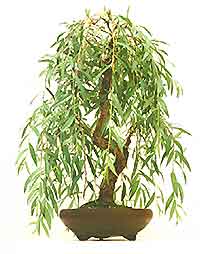Bonsai Trees
Tools

Good bonsai tools play an important part in the maintenance and styling of trees. They are specifically designed for use on bonsai trees and it is worth investing in at least a few of the more essential ones when starting out in this hobby.
It will certainly make working on your bonsai much easier and also help you achieve better results, rather than struggling with secateurs, which can be clumsy. When used properly and looked after well, good tools will last for many years.
There are only a few tools that are truly essential, but it is useful to gradually build up a good, varied collection of tools over the years, as you become more familiar with the different ways in which individual tools are used. It is important that you keep your tools in good condition - clean and oil them regularly to keep rust at bay and keep them sharp at all times. Blunt tools can damage a tree and wounds which have been cleanly cut will heal far more quickly and effectively.
Below are a selection of tools which are most often used:
1. Branch cutters - the most important tool for any bonsai enthusiast, available in a wide range of sizes. These will easily prune off all but the thickest of branches with one cut, flush to the trunk if necessary, leaving behind a small concave wound that heals neatly
2. Bonsai wire cutters - particularly useful for removing old wire from branches. The rounded tip enables wire to be cut from the branches without harming the tree. This is usually much better than unwinding the wire by hand, which can often cause damage to both branch and buds
3. Large scissors / shears - a good pair of sturdy scissors which can be used for a variety of purposes, such as general shoot trimming and root pruning
4. Long handled scissors - excellent for pruning small branches, especially those which are in difficult to reach twiggy areas of the tree
5. 'Snippers' - complete with a sprung handle, ideal for easy leaf pruning and fine shoot trimming
Other useful tools:
Pruning and Styling Tools
- Knob/wen cutters - similar to branch cutters and designed to remove branch stubs, leaving an excellent spherical concave cut. A very handy tool
- Saw - finely toothed for removing heavy branches, trunk tops and large tap roots. Fold-up saws are invaluable on collecting trips
- Clamps - used to bend or straighten thick branches and trunks. Apply extra cushioning at pressure points to prevent damage
- Tweezers - to remove small buds, surface weeds and dead leaves amongst dense growth
- Small pliers - helpful when wiring branches, to bend the end of the wire. Also to twist and tighten anchoring wires which secure the tree in the pot
- Bending levers - a long handle enables thick, wired branches to be easily bent
- Turntable - a must for any styling session, allowing the tree to be easily viewed from all angles. Use wedges or sand bags under the pot to change the trunk angle if required. Good turntables can be made from the base of office chairs or the swivel mechanism of a disused computer monitor
- Wire - available in a variety of different thickness and used for bending and positioning branches. Adonised aluminium or annealed copper wire is most suitable
- Wound sealant - cut paste or sealant in a tube, to protect and seal new cuts
Repotting tools
- Chopsticks - to carefully push the soil into any air pockets amongst the roots
- Sieves - different grades for sifting out large lumps from composts or eliminating fine dust from Japanese Akadama clay
- Toothbrush - good for cleaning algae from trunks and branches. Can also be used to expose surface roots
- Nylon bristled scrubbing brush - useful to remove compacted top soil and also to brush young surface roots outwards from the trunk, helping to position them for the future. Also ideal for cleaning pots
- Heavy duty root pruners - similar to branch cutters, but shaped like pincers and leaving a cut that is flat rather than concave. The long handles provide good leverage
- Fork or bonsai rake - to comb out and remove soil from outer roots
- Hook - another useful tool for combing out larger root balls
- Knife - often handy to cut down the sides of root ball when removing pot bound trees from their containers, especially when these are incurved
Carving Tools
- Chisels and carving tools - for hollowing out deadwood areas and providing texture. Chisels can also be used to tidy up clumsy cuts to allow better healing
- Jinning pliers - to gently crush branches for jinning so that bark can be easily stripped. May also be used when tearing wood or branches to create a jin/deadwood area
- Electric drills - a large variety of cutting and sanding bits enable convincing carving of driftwood areas and jins. Always take extreme care, wearing goggles and a breathing mask. Protect the tree to avoid damage
- Chain saw - used in extreme circumstances to reduce height of trees with thick trunks and also to initiate large carved areas
 Good bonsai tools play an important part in the maintenance and styling of trees. They are specifically designed for use on bonsai trees and it is worth investing in at least a few of the more essential ones when starting out in this hobby.
Good bonsai tools play an important part in the maintenance and styling of trees. They are specifically designed for use on bonsai trees and it is worth investing in at least a few of the more essential ones when starting out in this hobby.